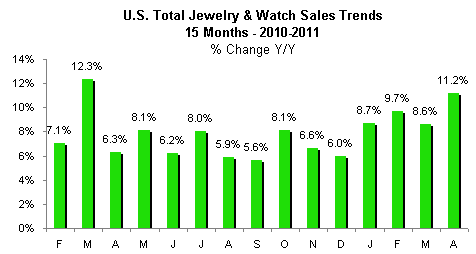IDEX Online Research: U.S. Jewelry Sales Pick Up In April
June 23, 11
(IDEX Online News) – Jewelry and watch demand strengthened significantly in April in the
The full analysis is available to IDEX Online Research subscribers and IDEX Online members here.
Further, total jewelry and watch sales for the first three months of 2011 were revised upward, and show a much more consistent, positive trend. Preliminary jewelry sales in prior months had been somewhat choppy – in line with the choppy post-recession economic growth. However, newly revised data shows a pattern of solid monthly sales gains.
The Department of Commerce also reported preliminary April sales for specialty jewelers: +20.8%. This number will be revised downward in the future, in our opinion. We’ve heard some success stories, but this reported preliminary gain is too robust, and it does not reflect the sales patterns reported by our sample of specialty jewelers.
However, directionally, the number is reflective of the positive trends which jewelers are reporting. As an aside, if this number had been reported for May, it might be believable: we’ve already seen May sales gains in the 20%-30% range from our sample.
The table below summarizes key jewelry sales trends in the
| Segment | $ Billions April 2011 Sales | % Change Year-to-Year |
| Total Jewelry Industry | $4.8 | +11.2% |
| Specialty Jewelers | $2.2 | +20.8% |
Here are the current jewelry and watch sales trends in the
· Total jewelry and watch sales showed a solid gain of 11.2% in April 2011 versus April 2010, based on preliminary numbers. Industry sales were an estimated $4.8 billion for the month, up from an estimated $4.3 billion a year ago. In part, the strong gain for April was due to a relatively easy comparison last year: a gain of only 6%, which was the smallest monthly gain in 2010.
· Total jewelry and watch sales were revised upward for the prior month – March 2011 – to a gain of 8.6% for the month (versus March 2010). Preliminary numbers had shown a much weaker gain of only 3.0%. We noted last month that March’s number appeared to be an aberration because it was so weak; the revised data is more in line with expectations.
· During April, specialty jewelers took significant market share from other merchants who sell jewelry, based on preliminary numbers. According to the Department of Commerce, specialty jewelers’ March sales rose by a robust 20.8%, a number that will be revised downward. This data is inconsistent with sales results obtained from the IDEX Online panel of jewelers; their gains were more modest. LGI Network (an NPD Group company) reported that sales of branded jewelry showed a gain of about 8%, this is directionally more consistent with our sample.
· Watch sales were up sharply in April: +13.9%. Further, prior months were also revised to show low double-digit gains. This data is also inconsistent with prior trends, as reported by the Department of Commerce. However, LGI Network data for watches showed a similar bullish trend: watch sales were up 11% in April based on total dollar sales of members of the LGI Network group.
· The jewelry and watch industry gained market share in April, when compared to sales trends in other retail categories. This is typical in a post-recession period. Historically, jewelry demand usually falls faster at the beginning of a recession, but recovers at a greater rate than retail sales in a post-recession era. Further, revisions made by the Department of Commerce for the first three months of this year show a similar trend: jewelers took market share from other merchants.
· The retail jewelry market remains bifurcated: low-priced and high-priced merchandise seems to be selling well, while goods priced in the middle - $500 to $1,000 – have experienced softer demand, though they are showing growth.
The graph below summarizes jewelry and watch sales in the
 Source: US Dept of Commerce |
Outlook Remains Positive
Despite near term challenges – the earthquake and tsunami in
While sales appear to be strong, we note that most of the sales gains are coming from higher retail prices. Jewelers have been raising prices to compensate for higher commodity costs – primarily gold and diamonds. Unit sales of jewelry remain tepid.
Based on four months of 2011 sales data, the
We’re skeptical of the Commerce Department’s numbers: a gain in the mid-to-high single digit range seems much more reasonable to us. This would yield jewelry sales in the $66-68 billion range for the year, rather than the government’s forecast of about $70 billion, an 11% gain. Further, over the next couple of years, we believe that jewelry sales gains will settle in at about 4% or so annually.
We look for significant revisions in the data that will be reported in early July. Thus, all of these robust trends may shrink somewhat, with the release of new data in a month or so.
The full analysis on